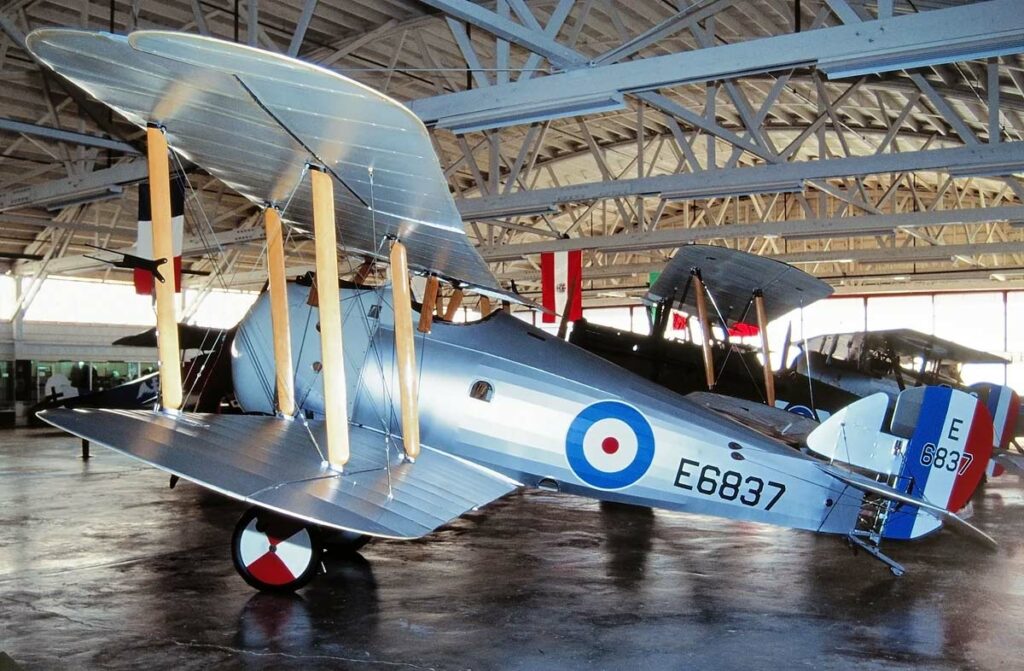The Sopwith Snipe 7F.1, a British single-seat biplane, was a late WWI fighter known for its excellent high-altitude performance and maneuverability. This article provides an in-depth examination of the Sopwith Snipe 7F.1, a fighter aircraft that represented the pinnacle of biplane fighter design during World War I. It outlines the aircraft’s development, design characteristics, performance capabilities, combat history, and eventual retirement.
The Sopwith Snipe 7F.1 is a defining aircraft of World War I’s aerial combat evolution. As a successor to the renowned Sopwith Camel, the Snipe was developed to secure air superiority with improved performance, especially at high altitudes where air battles were increasingly being fought towards the war’s end.
History of Development of the Sopwith Snipe 7F.1:
The Sopwith Snipe 7F.1 was developed by Sopwith Aviation Company against the backdrop of an escalating arms race in the skies of World War I. The conflict had quickly advanced aircraft technology, with fighters becoming increasingly important for reconnaissance protection, bomber interception, and air superiority.
The Sopwith Aviation Company, led by Thomas Sopwith, initiated the development of the Snipe as a replacement for the Sopwith Camel, aiming to address the older model’s shortcomings and to dominate the latest German fighters. The program was launched amid the quest for improved altitude performance, engine power, and pilot safety.
Design of the Sopwith Snipe 7F.1:
The design of the Sopwith Snipe was a reflection of its era’s technical advancements and combat needs. It maintained the biplane structure but incorporated a more powerful engine and a refined airframe for better high-altitude capabilities. It was equipped with a 230 horsepower (171 kW) Bentley BR2 rotary engine, which gave it superior performance compared to its predecessor, the Camel.
With a wingspan of 31 feet 1 inch (9.47 meters) and a length of 19 feet 10 inches (6.04 meters), the Snipe was designed to be robust yet maneuverable. It incorporated improvements in aerodynamics, a more comfortable cockpit with better visibility, and a harmonized control system that reduced pilot fatigue.
The armament of the Snipe was formidable for its time, comprising two .303 Vickers machine guns synchronized to fire through the propeller arc. The aircraft’s design balanced the needs of agility, speed, and firepower effectively but did have its drawbacks, such as the relatively high maintenance needs of its rotary engine and the initial lack of a reliable interrupter gear mechanism for its machine guns.

Performance of the Sopwith Snipe 7F.1:
The Sopwith Snipe’s performance was impressive for the time. The Bentley BR2 engine enabled a top speed of around 121 mph (195 kph) and a service ceiling of 20,000 feet (6,096 meters), with a range of approximately 300 miles (483 kilometers). This performance allowed the Snipe to engage enemy aircraft at higher altitudes effectively, where combat was increasingly taking place.
Compared to contemporaries like the Fokker D.VII, the Snipe was able to hold its own, thanks to its powerful engine and superior climb rate. It wasn’t as agile as some of its adversaries, but it brought increased durability and firepower to engagements, which were crucial attributes for the fighter’s role at the time.
Military Use and Combat of the Sopwith Snipe 7F.1:
In combat, the Sopwith Snipe acquitted itself admirably. It was introduced into service in the latter stages of World War I, with the Royal Air Force’s No. 43 Squadron being the first to operate the type in September 1918. Though its operational history was brief due to the war ending shortly thereafter, the Snipe was involved in several notable dogfights and proved to be a formidable adversary against German aircraft.
After the war, the Snipe continued in service, being used in various roles including as a standard fighter in the RAF until being replaced by more advanced types such as the Gloster Grebe. It saw action during the Russian Civil War and in the Middle East, where its robust design and powerful engine were advantageous. It was also exported to several countries, including Canada, Norway, and Australia.
The Sopwith Snipe 7F.1 stands as a significant transitional fighter between the end of World War I and the advancements that would come in the interwar period. Although its time in the limelight was brief, the Snipe’s contributions to fighter design and its service record solidify its place in aviation history as a commendable successor to the Sopwith legacy and a harbinger of future aerial combat principles.
Back to the Warbirds section.